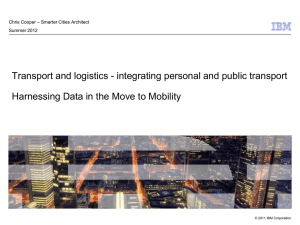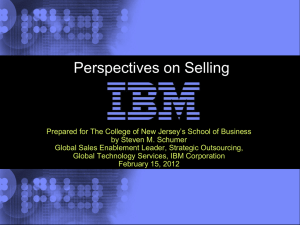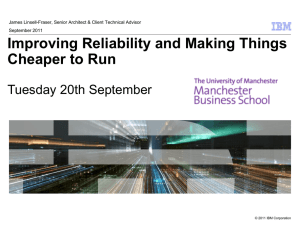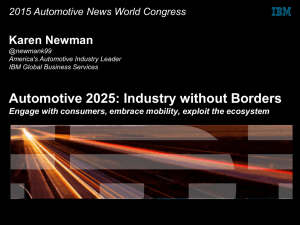Work/Life Integration at IBM
advertisement
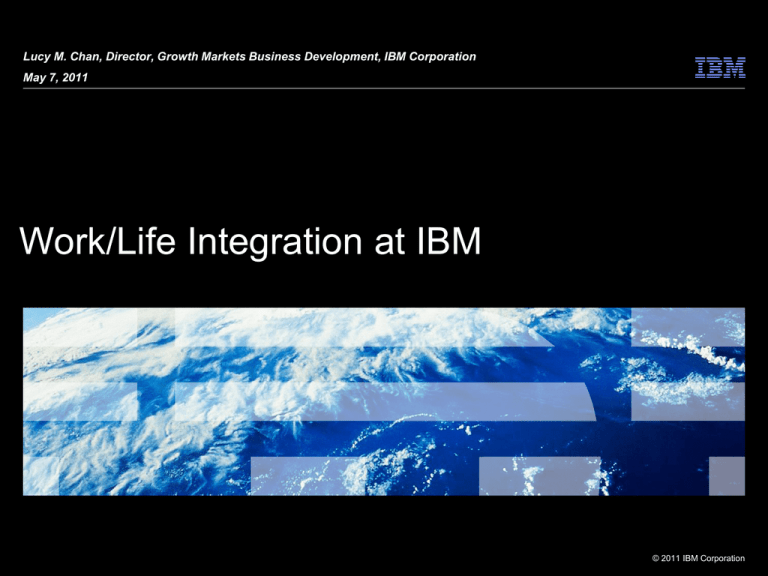
Lucy M. Chan, Director, Growth Markets Business Development, IBM Corporation May 7, 2011 Work/Life Integration at IBM © 2011 IBM Corporation 2011 IBM Work/Life Program Heritage 1956 – to Date 2010 2009 2001 1999 1997 1992 1980’s 1986 1983 1966 1956 2 4th Global Work Life Survey Work Life Zone Global Work Life Fund FWO’s in 11 LA countries Regular Part-Time FWLOA extended to 5 years Individualized Work Schedules First Work Life Survey Child Care Resource & Referral Special Care for Children Leaves of Absence © 2011 IBM Corporation The Changing World of Work … Transforming “Work/Life Balance” to “Work/Life Integration” Increased global contacts result in the disappearance of “9 to 5” and fixed continuous schedules Evolving family and social structures drive employee needs, perceptions and expectations Ubiquitous low cost technology enables and generates work 24x7x365 from any location Enabling the Global Enterprise 3 © 2011 IBM Corporation IBM Corporation Executive Quote "One of the reasons people come to work for IBM is because we take workplace flexibility seriously. On any given day, worldwide, one third of our people are not at an IBM location - they are working onsite with customers, are telecommuting or are mobile. Today, we must reconsider our traditional concept of work and how it gets done..." Samuel J. Palmisano, IBM Chairman of the Board and Chief Executive Officer 4 © 2011 IBM Corporation Mobility is a continuous journey IBM began its mobility program in the early 1990’s and now supports over 160,000 employees worldwide Mobility Objectives Increase customer satisfaction Improve employee productivity Generate significant cost savings Improve attraction and retention of talent 1995: 10,000 employees in the US Target Workforce Segments Sales Client Services & Support 5 1998 – 2000: Global implementation 2010: 160,000 formally identified remote workers 2011: Workplace of the Future; enable full mobility Increasingly, more jobs can be performed remotely © 2011 IBM Corporation The Changing Work Environment in IBM 1998 H (home) 0.4% M (mobile) 10.6% 2010 C (customer) 1.4% T (m u l ti o ffi c e ) 1 .0 % C (c u s to m e r) 3 .0 % H (h o m e ) 8 .0 % Un k n o wn 4 .0 % N (non-office) 13.1% M (m o b i l e ) 2 1 .0 % S (o ffi c e 6 1 .0 % N (n o n o ffi c e ) 2 .0 % S (office) 74.5% 6 © 2011 IBM Corporation Flexibility Principles 7 1. The Enterprise never stops 2. Balancing of needs 3. Trust and personal responsibility 4. Range of options 5. Understanding differences 6. Focus on results © 2011 IBM Corporation IBMers Have Options on How, When & Where to Work: Flexible Work Options (FWOs) Compressed Flexible Work Week Individualized Work Schedule Leave of Absence Part-time Reduced Work Schedule Job Share Mobile Work–at–Home 8 © 2011 IBM Corporation Work Life Tools 9 © 2011 IBM Corporation IBM Global Work/Life Fund: $50M Multi-Year Fund Primary Goals: • Enhance IBM’s position as THE global work/life leader • Contribute to the recruitment and retention of top talent Mission: • Increase supply and improve quality of dependent care where our employees live and work by providing attainable and desirable dependent care options to employees … locally recognized as high quality, desirably priced, convenient • Provide support with consideration given to local culture, norms and standards and international values • Provide support along the career life cycle to key talent • Recognize and respond to emerging markets and changing workforce demographics and needs (e.g., mobile, frequent traveler, aging, young) • Provide tools/supports for managers and employees to better take advantage of flexibility 10 © 2011 IBM Corporation Resource & Referral Programs Work/Life Resource and Referral (R&R) is a service developed to help employees manage work and personal responsibilities by providing information on topics and services that are important to them: R&R in the United States R&R Globally Provided – – Launched in 2005 as the first ever Global R&R Available in 31 countries and 8 languages with enhancements and expansions into more countries planned: • Argentina, Australia, Brazil, Chile, China, Colombia, Czech Republic, Ecuador, Hong Kong, Hungary, India, Indonesia, Ireland, Northern Ireland, Mexico, New Zealand, Peru, Philippines, Poland, Russia, Scotland & Wales, Singapore, Slovakia, South Africa, Spain, Taiwan, Thailand, UK England, Uruguay, Venezuela Unique R&Rs in different countries: • 11 Australia, Brazil, Canada, France, Germany, Japan, Switzerland © 2011 IBM Corporation IBM achieved cost savings and improved client & employee satisfaction through mobility (hidden) Company Benefits Substantial real estate savings Increased employee retention Enhanced productivity Lower absenteeism Increased revenue Increased customer satisfaction Better accessibility to IBM team More “face time" with IBMers More productive at customer site Faster response to inquiries (hidden) Real Estate Savings (hidden) Employee Benefits Mobility centers saved 2 million square feet and 7,500 workspaces Savings and/or cost avoidance of approximately $100 million each year (hidden) Environmental Benefits Eases traffic congestion on freeways More efficient energy use Cleaner air - 1990 federal clean air act 12 Customer Benefits Productivity improvement More “face time" with clients Improved customer satisfaction More accessible and responsive Work longer hours with less impact on personal / family life Higher morale Greater loyalty Use what we sell © 2011 IBM Corporation Mobility @ IBM : Summary Then and Now IBM began to formalize mobility as a program in 1995 Today more than 40% of IBM’s workforce works remotely Benefits Significant Real Estate cost reduction Supports Green initiatives Enhances workforce productivity & morale Supports global integration and business continuity Critical Success Factors Holistic approach and cross-functional program support Clear mobility policies – HR, technology, expense, procurement, etc Technology as an enabler Executive Champion 13 Getting There Define objectives and align to business strategy Identify program champion and owner Governance Education Technology Policies Metrics Formalize the program Processes Pilot and adjust Continuously improve © 2011 IBM Corporation Workplace of the Future What we know about people and work . . . Work used to be a “place”, now it's any place Growing mobile/OTTO (Other Than Traditional Office) workforce Need to work across time zones and geographies (peer-to-peer video) The proliferation of devices... work doesn't have to be done on a laptop anymore Technology enabling a different kind of work and culture Entrance of Gen Y ... the social media generation 14 © 2011 IBM Corporation Workplace of the Future recognizes and supports generational diversity Experienced workers (Age 50 +) growing as % of workforce wisdom and intellectual capital of the organization email 15 Mid- career (Age 35 – 50) shrinking as % of workforce essential professionals and middle managers instant messaging New generation (born after 1980) growing as % of workforce critical to long-term viability and innovation social networking © 2011 IBM Corporation Roadmap Formalize the enterprise objectives for mobility Identify Executive champion(s) Engage stakeholders Align the mobility program to the business strategy and objectives Formalize the mobility program • Governance • Education • Processes and Controls • Enablers • Policies • Metrics Conduct a trial, refine the program, expand Assign program ownership Continuously assess and update 16 Thank-you! Lucy M. Chan, IBM lmchan@us.ibm.com © 2011 IBM Corporation
